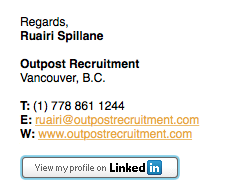
Ruairi Spillane
Founder Outpost Recruitment
LinkedIn has become a crucial networking, information sharing and personal branding tool for construction and engineering professionals. Ignore it at your peril. Let’s focus on the numerous positives that can come from having an online professional profile.
We can help you find a role in Canada's construction sector.
Get started by registering with us—it's free!
Why is LinkedIn useful?
LinkedIn allows you to organize your professional connections, build an online presence and leverage common connections with other members of your network.
You can build connections that can assist you in meeting your professional objectives and engage with them. Whether you are searching for a job, keeping up to date on your field or looking to advance your career, learning how to use LinkedIn can help you achieve your goal.
Build rapport — If you’ve seen topical and relevant third-party articles, or have timely opinions on issues in your industry, you can post these on your profile or selected groups. This can help you engage with your existing network, and build new contacts. While it’s good to post often, remember that you should be aiming for quality over quantity.
Industry news — Your news feed will become an information resource for keeping in touch with latest events in your industry. Get involved in industry discussions and see what you can learn! Connect with our Outpost Recruitment group for latest industry news.
Warm introduction — LinkedIn allows you to establish degrees of separation when browsing for target individuals. Instead of a cold invitation to a stranger who does not know you, you may avail of the opportunity to ask a common (2nd degree) connection to introduce you. This is a very powerful networking tool.
Cold introduction — If you wish to be particularly proactive about exploring new opportunities, don’t be afraid to ‘reverse headhunt’. Learning how to use LinkedIn’s search tools means you can do this quickly and effectively. This essentially means identifying suitable companies or individuals to contact directly through the LinkedIn messaging feature. Providing a customized message explaining why you wish to connect is vital. Don’t just send a generic request, show them you have taken the time to study their profile.
Interview Preparation — Learn about the background of the hiring manager you are about to meet. This will help you understand the interview team and prepare some quality questions to ask. You may establish that you have common connections or else mutual interests with your future employers so don’t be shy on doing your research.
How to use LinkedIn to grow your network
Send connection requests to professional contacts once a relationship has been developed. Remind them of how you met if you sense they may not remember you. It’s always better to send a customized message when connected and ensure you follow up once your connection is accepted. Avoid connecting with strangers without sending a clear message on the purpose of connecting with them!
Join LinkedIn groups according to your industry, professional organization and regions to meet other professionals with common interests and keep you up to date on developments in your industry. Our Outpost Recruitment group posts the latest industry and jobs news, so be sure to connect with us to stay up to date.
Add a LinkedIn badge to your email signature. This will encourage people you are emailing to connect with you.

Success Tips
LinkedIn is a fantastic tool for promoting your career interests, so ensure you maintain a complete profile and communicate a positive, professional online image. First impressions last. Like most tools, keep in mind the expression “Garbage in, garbage out!”
A concise heading and title is important. These two parameters are crucial, and it’s important that you convey the appropriate message to viewers. For example, if you are job hunting, you can convey that by stating you are “seeking new opportunities in . . . ” on your profile.
Recommendations are handy, so ask colleagues, direct supervisors and happy clients to endorse your work as this greatly enhances your professional image, especially if you are job searching.
You can also use a LinkedIn request as a subtle way to nudge someone you have recently contacted. Instead of following up by email, send them a connection request and send your follow up email at a later date.
How to build a LinkedIn profile to impress
Professional photo — A high-resolution professional photo adds personality to your profile. A cropped image of you standing next to someone else at a dinner party, graduation photos or grainy historical images do not help your personal branding!
Clear objectives — Similar to your CV/resume, your profile should include a personal summary that is clear and concise. Who are you looking to network with? What types of roles interest you?
Relevant detail — Provide as much detail as possible about your results and achievements during your current and previous roles. Highlight a basic scope of each project you have worked on so anyone can visualize the tasks and your involvement.
Keyword loading — Optimizing your profile for searches is critical. Loading your profile with keywords associated with your desired role will return your profile in searches by recruiters. If you do not want your desire for a new role to be blatant, it is a good idea to embellish your profile with subtle keywords such as ‘seeking’, ‘opportunities’ and ‘new challenges’. Otherwise, being explicit with the fact that you are actively looking will attract the attention of hirers.
Increase your visibility — Joining relevant groups and being active in group discussions can increase your footprint within industries and can drive traffic to your profile. You’ll quickly discover this is how to use LinkedIn in a way that attracts interest in you.
Custom URL — By default your public link to your profile may contain a lengthy URL that looks like “tr.linkedin.com/pub/johnadams/70/887/b01/”. Ensure you shorten the URL if you would like to place this link on your resume or signature. See our How to create a short, custom LinkedIn profile URL guide for instructions.
Best of luck with your online networking. Don’t forget to connect with my LinkedIn profile and follow Outpost Recruitment.
We can help you find a role in Canada's construction sector.
Get started by registering with us—it's free!

Ruairi Spillane
Founder Outpost Recruitment